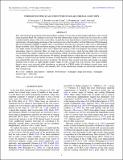Files in this item
Unresolved fine-scale structure in solar coronal loop-tops
Item metadata
| dc.contributor.author | Scullion, E. | |
| dc.contributor.author | Rouppe van der Voort, L. | |
| dc.contributor.author | Wedemeyer, S. | |
| dc.contributor.author | Antolin, P. | |
| dc.date.accessioned | 2017-02-14T10:30:23Z | |
| dc.date.available | 2017-02-14T10:30:23Z | |
| dc.date.issued | 2014-11-24 | |
| dc.identifier | 248969759 | |
| dc.identifier | b44dda17-2073-4f33-a574-61f07db5acc2 | |
| dc.identifier | 84914678265 | |
| dc.identifier.citation | Scullion , E , Rouppe van der Voort , L , Wedemeyer , S & Antolin , P 2014 , ' Unresolved fine-scale structure in solar coronal loop-tops ' , Astrophysical Journal , vol. 797 , 36 . https://doi.org/10.1088/0004-637X/797/1/36 | en |
| dc.identifier.issn | 0004-637X | |
| dc.identifier.other | BibCode: 2014ApJ...797...36S | |
| dc.identifier.uri | https://hdl.handle.net/10023/10288 | |
| dc.description.abstract | New and advanced space-based observing facilities continue to lower the resolution limit and detect solar coronal loops in greater detail. We continue to discover even finer substructures within coronal loop cross-sections, in order to understand the nature of the solar corona. Here, we push this lower limit further to search for the finest coronal loop substructures, through taking advantage of the resolving power of the Swedish 1 m Solar Telescope/CRisp Imaging Spectro-Polarimeter (CRISP), together with co-observations from the Solar Dynamics Observatory/Atmospheric Image Assembly (AIA). High-resolution imaging of the chromospheric Hα 656.28 nm spectral line core and wings can, under certain circumstances, allow one to deduce the topology of the local magnetic environment of the solar atmosphere where its observed. Here, we study post-flare coronal loops, which become filled with evaporated chromosphere that rapidly condenses into chromospheric clumps of plasma (detectable in Hα) known as a coronal rain, to investigate their fine-scale structure. We identify, through analysis of three data sets, large-scale catastrophic cooling in coronal loop-tops and the existence of multi-thermal, multi-stranded substructures. Many cool strands even extend fully intact from loop-top to footpoint. We discover that coronal loop fine-scale strands can appear bunched with as many as eight parallel strands within an AIA coronal loop cross-section. The strand number density versus cross-sectional width distribution, as detected by CRISP within AIA-defined coronal loops, most likely peaks at well below 100 km, and currently, 69% of the substructure strands are statistically unresolved in AIA coronal loops. | |
| dc.format.extent | 10 | |
| dc.format.extent | 3819728 | |
| dc.language.iso | eng | |
| dc.relation.ispartof | Astrophysical Journal | en |
| dc.subject | Methods: data analysis | en |
| dc.subject | Methods: observational | en |
| dc.subject | Techniques: image processing | en |
| dc.subject | Techniques: spectroscopic | en |
| dc.subject | Telescopes | en |
| dc.subject | QC Physics | en |
| dc.subject | QB Astronomy | en |
| dc.subject.lcc | QC | en |
| dc.subject.lcc | QB | en |
| dc.title | Unresolved fine-scale structure in solar coronal loop-tops | en |
| dc.type | Journal article | en |
| dc.contributor.institution | University of St Andrews. Applied Mathematics | en |
| dc.identifier.doi | https://doi.org/10.1088/0004-637X/797/1/36 | |
| dc.description.status | Peer reviewed | en |
| dc.identifier.url | http://adsabs.harvard.edu/abs/2014ApJ...797...36S | en |
This item appears in the following Collection(s)
Items in the St Andrews Research Repository are protected by copyright, with all rights reserved, unless otherwise indicated.

